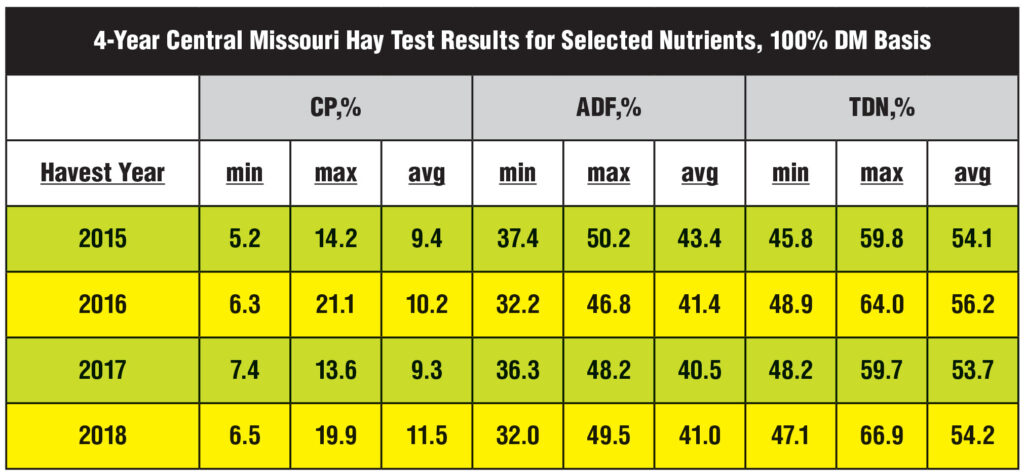Building a cost-effective feeding program based on forage testing data
Cattle producers know all too well the balancing act needed to ensure their herd receives the nutrition it needs. The winter months create a more challenging environment due to producers’ reliance on hay and other feedstuffs to meet animals’ nutritional demands.
When producers utilize hay testing, they have a better grasp of the nutritional components in their dry forages. Producers can use the results of hay tests to build a feeding program that fills in the nutritional gaps, so their animals receive the all the nutrients needed to thrive.
Nutrient Variability
Energy and protein levels present in hay bales vary greatly. University of Missouri Livestock Extension Specialist Gene Schmitz analyzed results from grass hay samples compiled over the course of several years. Schmitz’s analysis showed significant variation in the minimum and maximum levels of crude protein (CP), acid detergent fiber (ADF) and total digestible nutrients (TDN) between each lot of hay.
The difference in nutritional values might be surprising to some producers. “It’s a wide range, much more than what you might anticipate. And I don’t think producers are aware that the range of those things are as wide as it is,” Gene Schmitz, University of Missouri livestock extension specialist, explained. “There is a huge difference in these forage qualities. That’s why average hay quality is meaningless really because it is so variable.”
The research revealed in some cases the percent of crude protein varied by as much as 15 percent. Additionally, the total digestible nutrients showed almost 20 percent difference in some samplings. “With that kind of variation, it is extremely difficult to try to predict what forage quality might be and what supplementation programs might need to be implemented without having any kind of knowledge of what those numbers are,” Schmitz said.
Plant maturity at harvest plays a big role in determining forage quality. The variability seen between hay samples many times is tied to when the forage was harvested.

Benefits of Hay Testing
Collecting hay samples allows producers to understand more precisely what kind of nutrients are available in the dry forage they are feeding their livestock. Producers can utilize the hay test results to guide them to supplement the appropriate nutrients that might be missing from the forage component of the animal’s diet. Knowing the forage quality allows producers to more precisely develop cost-effective supplements to fill the nutritional holes.
The information from a hay test also allows producers to better match animal nutrient demands based on stages of production. For example, producers may want to feed lower quality hay to the animals with the current lowest nutrient requirements, such as cows that have just weaned their calves and are in good body condition.
Results from a hay test can be particularly important in times when forage supplies are low, and producers are purchasing hay. To get the most for their money, producers will want to know the nutritional content of what they are buying to feed their herd.
Additionally, the information gleaned from a hay test gives producers the opportunity to spend their money more accurately where it is needed. “It is particularly important when feed prices are high like they are now. We don’t want to guess on the supplement,” Schmitz said. “We want to find out what we need and then find the cheapest source of those nutrients.”
Procedure and Costs
Livestock extension specialists recommended producers utilize a hay corer to sample a cross section of a bale. Typically, a solid sample size includes cores taken from 10 bales in each lot of hay. The cost of a hay test ranges from $20 to $30 dollars depending on the lab and the type of analysis conducted.
Next Steps
After producers receive their hay test results, the next step is to work with beef nutrition specialists to design a feeding program based on what the forage analysis indicates. Then using the information and guidance from experts, producers can build a cost-effective, nutritionally comprehensive feeding program.





